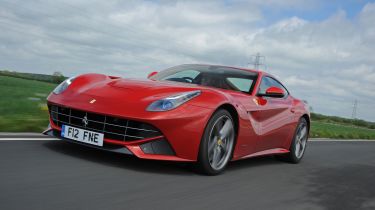Ferrari F12 Berlinetta
We test the Ferrari F12 Berlinetta on UK roads for the first time. It’s dramatic, but is it brilliant?

The F12 Berlinetta is an incredible car and a real technical achievement – but it’s not the best Ferrari you can buy. For handling, the 458 Italia is better; for covering long distances, the larger all-wheel-drive FF is more capable; and for those wanting the ultimate supercar from the brand, there’s the forthcoming hybrid LaFerrari. Still, the F12 is a gorgeous-looking car and there’s a tangible thrill you get from driving it that makes us glad that it exists.
Is there really any need for the Ferrari F12 Berlinetta? It’s a question you could be forgiven for asking of this £240k supercar when there are so many other exotic models on the road. But when we fired up the big V12 for the first time on British soil, we had another, more pressing question: exactly how ferocious is it?
Anyone who says supercars are no longer intimidating hasn’t seen the F12’s performance stats, and then signed a form agreeing to pay Ferrari for any damage.
The engine is a development of the 6.3-litre from the FF, only here power is up from 660bhp to 730bhp. And it’s all sent to the rear wheels. So for the first few minutes in an F12, most people will tread on the throttle pedal as if it’s glass.
Used - available now

2020 Suzuki
SX4 S-Cross
46,548 milesManualPetrol1.4L
Cash £11,997
2020 BMW
X2
44,368 milesAutomaticPetrol2.0L
Cash £14,997
2021 SEAT
Ibiza
18,736 milesManualPetrol1.0L
Cash £14,897
2023 Land Rover
Discovery
13,183 milesAutomaticDiesel3.0L
Cash £57,500Pottering around in this car highlights a few things: the steering is light, the gearbox is smooth in fully automatic mode, the powerful carbon ceramic brakes aren’t too grabby and, with the adaptable suspension set to “bumpy road”, the ride is supple for a supercar.
Aside from the way it wants to follow cambers, this Ferrari is very easy to drive slowly. But what’s the point of blowing £239,317 on a thoroughbred prancing horse if you’re never going to venture beyond a trot? So there’s only one thing for it. Grip the wheel, clench your teeth and nail it!
The very moment your right foot squeezes the pedal, the F12 squats down on its haunches and catapults you towards the horizon, with the seven-speed dual-clutch gearbox shifting as quickly as you can snatch at the steering wheel paddles.
It’s a testament to Ferrari’s excellent electronic differential and perfectly judged driver aids that unleashing the 690Nm of torque doesn’t annihilate the rear tyres in an instant. But there’s no smoke; just a sense of rocket-like thrust, a blurring of the scenery and a loud, rasping, metallic howl from the exhausts.
The way the F12 builds speed is truly incredible. It would probably be even more incredible if you could tell just how fast you were going. As if your brain didn’t already have enough to cope with, Ferrari has given it the added challenge of deciphering the F12’s tiny speedometer – although you can switch the display to a digital readout.
With 0-62mph taking just 3.1 seconds and 0-124mph a barely believable 8.5 seconds, the chances are if you’ve pushed the accelerator all the way in, then you’re already over the speed limit anyway.
Interior quality is excellent, but there are some Italian foibles. Having the controls for the windscreen wipers and indicators on the face of the steering wheel is annoying, while it doesn’t make much sense that sat-nav, infotainment and in-car displays are all on two small TFT screens either side of a huge rev counter. And who knows how you access all the car’s available menus?
Thanks to the Audi influence, a Lamborghini Aventador’s interior is more logical. Yet arguably, it’s more flamboyant. Amazingly, driving the F12 through London failed to draw quite the attention we were expecting. People weren’t quick to notice the exquisite details like the ‘aero-bridge’ above the front wheelarch, which channels air smoothly down the sides of the car and over the rear wheels, or the active aerodynamic vanes in the front intakes.
Still, it’s touches like these which make the F12 twice as aerodynamically efficient as its predecessor – the 599. It’s 70kg lighter as well, and when you combine that with a lower centre of gravity than the old car’s, the newcomer feels far more agile.
Some may find the steering a bit quick and light, but it soon begins to feel natural. There’s just so much traction and grip that eventually even the most faint-hearted will turn the steering wheel-mounted manettino switch from Sport to Race mode, which limits the assistance from the car’s computers. But there’s no getting away from the fact this is a 730bhp supercar, and you need to treat it with respect.
By comparison, the Ferrari 458 feels tame, meaning you can exploit more of its brilliance more of time, which ultimately makes it a better supercar. Okay, so with a boot bigger than a Volvo V40’s, the F12 is better for crossing continents. But if you want a practical Ferrari, there’s the four-seat, four-wheel-drive FF.
So is there any need for the F12? Absolutely not. But then ‘need’ and ‘want’ are two completely different things…







